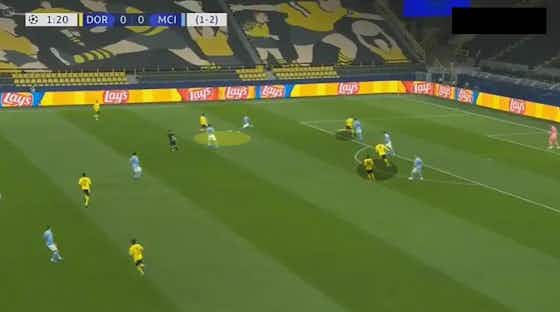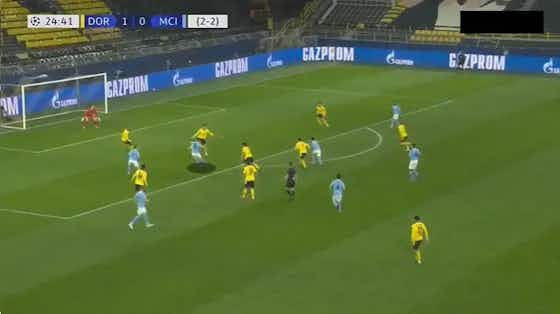Media Referee
·16 April 2021
Breaking the curse – How Manchester City saw off Borussia Dortmund despite second-leg scare

Media Referee
·16 April 2021

Manchester City have won every domestic trophy in the past decade but the biggest trophy in club football continues to evade them. They have gotten close to being on the grandest stage of them all on many occasions but keep falling short.
Another situation of elimination arose when Borussia Dortmund scored in their 2nd leg UEFA Champions League quarter-final tie. The then 1-0 scoreline put the aggregate scoreline on 2-2, with the Black and Yellow looking set to go through on away goals at the expense of the Premier League leaders.
But Pep Guardiola’s side fought back, scored twice, and went on to progress for just the 2nd European Cup semi-final appearance in their 127-year history. Let us now look at how this result came about and how Guardiola managed the second leg to perfection.
The first leg result, a 2-1 win for City, was not seen as a total disaster for Dortmund considering they got the all-important away goal. This meant a solitary goal and a clean sheet in the second leg would mean that they were the team going through to the last four.
An 84th-minute Marco Reus goal in the first leg put the score at 1-1 and a late Phil Foden goal was still not enough to calm City’s nerves. The Blue side from Manchester dominated proceedings then, with 62% possession and more shots than Dortmund. The real task was taking this intensity in the decisive second leg. (h/t Transfermarkt)
All eyes were now on City and how they wanted to approach the game. The equation was obvious; if the scoreline stayed at 0-0, City were through. So Dortmund had to attack. City had the option of either protecting their first-leg lead or go on the attack and try to kill the game off.
Pep Guardiola went with a team of midfielders, just like he did in the first leg. There was no out and out striker in the starting XI on both occasions. The first leg saw a 4-2-3-1, while the second leg had a 4-3-3 set-up. The team was exactly the same in both legs except for Oleksandr Zinchenko replacing Joao Cancelo at left-back in the second leg.
De Bruyne was listed as the centre-forward on paper but the post-match average positions of the players in Image A tells a different story. It clearly shows the intent of City to overload the midfield with technically-gifted midfielders and control the game.

As for Dortmund, their line-up was exactly the same in the two legs. A 4-3-3 was deployed on both occasions. And their tactics in the second leg started to work.
The biggest takeaway from the first 20 minutes of the second leg was the intensity of Dortmund. City are a possession-based team who really like to play out from the back. Just consider the fact that they keep, at an average, 60.9% of the ball each game in the Premier League so far this season.
So Edin Terzic recognized that and advised his players to press high up the pitch from the get-go. And surprise, surprise, it was working very well. Image B shows that as early as the first 90 seconds, Dortmund got men up the field.
The yellow circle is the area where Manchester City lost the ball. Now, Dortmund have three men (black circle) playing at City’s last line to help the attack after the ball is won. Fortunately for City, the play was stopped due to an offside. But Dortmund’s intent was clear.

For some reason, City players were occasionally playing a slightly higher line in defence. This was seen even when they weren’t being countered. This led to the game’s first goal as well. As Image C shows, a ball deep from Dortmund’s half by Emre Can found Erling Haaland (yellow circle), who was allowed to run in deep behind City’s high line. His run is indicated by the black line.
He cut the ball back to Jude Bellingham, who curled one into the top-right corner. The shot was met by Ederson but his hands weren’t strong enough to tip it past the post. Dortmund now had a 1-0 lead and were qualifying on away goals. City not only needed a goal, they now had to fix their defence so they would not concede more.

City were now rocked. And they came back to their senses in due time. In the next 40 minutes or so, there were no instances of Dortmund running in behind the City backline. City avoided the Dortmund press high up the pitch due to two reasons now.
They started to pelt Dortmund with attacks as the German side decided to sit back and defend. An example of this is shown in Image D where you can see the Dortmund bodies that are back and the City players that are attacking. And mind you, this was the first half. These images usually show up at the end of the games when desperation gets the better of teams.

There are 16 players (7 City, 9 Dortmund) in that frame. De Bruyne’s shot, which resulted after he pressed and won the ball in Dortmund’s box, hit the post. That’s desperate stuff already. But it really paid off when City got a stroke of luck in their favour for their persistence. They kept pushing and pushing and were awarded a penalty for handball in the 52nd minute when Can handled Phil Foden’s cross.
Mahrez dispatched the controversial penalty to make the score 1-1 in the 55th minute. But to highlight that this wasn’t completely a stroke of luck and a goal against the run of play, we see Image E.
The image displays the number of shots taken by both teams and some important statistics from minute 18 and 59 (After Manchester City conceded until just after they scored their equalizer).

So, as you can see, the pressure from City was intense. Dortmund were pegged back and it was due to City’s constant attack that they eventually got a penalty, even though it was pretty lucky. But no one can say that the Citizens were not trying. However, one could say that Dortmund’s timid approach to the game also helped City pelt the pressure.
It was simple now. If Dortmund scored, the game goes to extra time. If City score, the game is over as the Bundesliga outfit would need 3 goals to qualify then. So the next few minutes were important. City had to stop attacking so much and become conservative.
And they balanced it out pretty well. Image F shows City’s men falling back to help out the defence against a Dortmund attack after the scoreline was 1-1. Dortmund were now with the onus of scoring and City understood that the dynamics of the game will change considering they are the ones now being changed.
And mind you, this image is from when City were being countered. They had enough men back to defend and City players fell back with urgency. Ruben Dias (light blue circle) blocked Mahmoud Dahoud’s shot (yellow circle) and the attack fizzled out.

City’s full-backs, Kyle Walker and Oleksandr Zinchenko, were now more conservative. This is evident in Image G, which is in the build-up of the same attack as above. You can see the English and Ukrainian full-backs (black circle) so far back in their own half to defend against the counter.
Manchester City had just lost the ball, and if they pushed up, Guardiola’s men would have been completely open at the back. So City curbed their insatiable greed for goals and stopped their full-backs from exploring too far up the field.

The entire City front-4 (de Bruyne, Bernardo Silva, Foden, and Mahrez) seemed to be playing in a fluid system. The interchange in positions was evident every now and then, but Pep was very strict with his wing play.
Phil Foden was assigned the role down the left wing, similar to his first-leg role. The young Englishman kept Raheem Sterling out of the line-up for this match and that decision paid dividends. He was a constant threat down the left-hand side and took all the onus of the attack down that side upon himself.
The first penalty resulted from his deep run into the box and a cross that touched Can’s hand. His second goal, which came via a thunderbolt strike in the 76th minute, booked City’s place in the semi-finals then and there. He was impeccable and got a goal each in both legs.
So, now we know. Pep Guardiola managed the game pretty well. Going into the match knowing your opponents will attack you from the get-go to score a goal is never an easy feeling. They did concede, but they also learnt from it.
The defensive mistakes by Manchester City reduced as they put their foot on the pedal. Their imperious attack saw them score twice. And their defensive approach was sturdy enough to not allow Dortmund a clear chance to score. Their xG (expected goals) of 2.3 in that game was almost 4 times that of Dortmund’s 0.6 The difference between the two sides was clear and the best side won.






























































